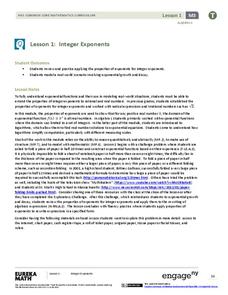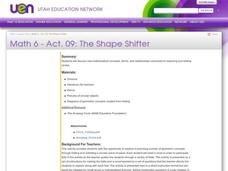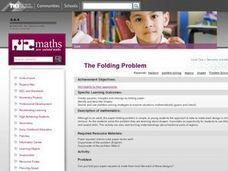Curated OER
Flight Dreams - Folding into Flight
Combine measurement, following directions, physics, and art with one fun activity. Learners read a set of instruction to create three different kinds of paper airplanes. They measure, fold, and fly the planes, and record data and answer...
Curated OER
Folding Fractions
Students create a set of fraction circles using a paper folding technique. They fold 10 inch circles of paper into the indicated fractions, identify the fractions, and use them to show equivalency.
Teach Engineering
Building-Testing-Improving Paper Airplanes: Head's Up!
Take foldables to all new heights. Pupils build and fly different types of paper airplanes in the 14th portion of a 22-part unit on aviation. Groups collect data on distance and flight time for each plane and compare the data from the...
Curated OER
Symmetry of the Addition Table
Help your class discover the commutative property of addition with this exploration of the addition table. By folding and coloring the table, a symmetry is found that directs students to an understanding of this crucial mathematical...
EngageNY
Integer Exponents
Fold, fold, and fold some more. In the first installment of a 35-part module, young mathematicians fold a piece of paper in half until it can not be folded any more. They use the results of this activity to develop functions for the area...
Exploratorium
Cut-Fold-Staple
Here is an interesting activity that combines paper folding art and geometry. In it, learners have a stack of index cards that are bound together. They draw a shape on it, and cut out the shape. When they unfold their shape, they have...
Curated OER
Folding Shapes; Are the Sides the Same?
Second graders explore geometry by experimenting with fold-ables. In this geometric shapes lesson, 2nd graders utilize cutout shapes from construction paper which they experiment with by folding. Students examine the symmetry and...
Curated OER
How Do Your Students Measure Up?
Students participate in a paper folding activity that has them create a ruler for measuring to the closest 1/16th of an inch.
Curated OER
Folding Circles
Students explore circles. In this introductory geometry lesson, students cut out a circle and follow a series of instructions given by the teacher. Students fold the circle, answer questions, and draw conclusions.
Pedago Net
Angles Fortune Teller
Young mathematicians use this activity-based worksheet to practice identifying various angles and triangles. The outline of the sheet allows for easy folding and cutting. When completely folded, the picture flap should match up with the...
EngageNY
Writing and Evaluating Expressions—Exponents
Bring your young mathematicians into the fold. Scholars conduct an activity folding paper to see the relationship between the number of folds and the number of resulting layers in the 23rd installment of a 36-part module. The results of...
Curated OER
Comparing and Ordering Fractions, Mixed Numbers, and Decimals
Create your own fraction kits by folding and labeling paper using fraction vocabulary. Learners then work in groups to use these in comparing and sequencing both whole numbers and fractions. They also create unit cubes and develop an...
Illustrative Mathematics
Toilet Roll
Potty humor is always a big hit with the school-age crowd, and potty algebra takes this topic to a whole new level. Here the class develops a model that connects the dimensions (radii, paper thickness, and length of paper) of a common...
Curated OER
Initial Fraction Ideas Lesson 10: Overview
Third graders use strips of paper to find equivalent fractions. They will fold paper into thirds and shade 2/3 of the paper. Then fold the same paper in six parts and predict how many parts will be shaded. They will repeat again folding...
Curated OER
Equivalent Fraction Paper Strips
Young learners compare the relative values of fractions by making physical representations. They fold and label strips of paper that are equal in length to represent "one whole" and the equal parts that fractions represent. Also, they...
Virginia Department of Education
Exponential Modeling
Investigate exponential growth and decay. A set of six activities has pupils collecting and researching data in a variety of situations involving exponential relationships. They model these situations with exponential functions and solve...
EngageNY
Analytic Proofs of Theorems Previously Proved by Synthetic Means
Prove theorems through an analysis. Learners find the midpoint of each side of a triangle, draw the medians, and find the centroid. They then examine the location of the centroid on each median discovering there is a 1:2 relationship....
Aunt Annie's Crafts
Interlocking Box
Cutting, pasting, folding. Kids' small motor skills get a workout making interlocking boxes that can be used as gifts or decorations. A variety of templates are included in the resource.
Scholastic
Study Jams! Lines of Symmetry
Line up this lesson when introducing symmetry to your young mathematicians. Watch how two figures are introduced to different ways of folding and identifying whether or not they are actually symmetrical. Finish the lesson with a multiple...
Alabama Learning Exchange
Origami Geometry
Origami is an excellent way to combine Japanese culture, art, and geometric shapes into one engaging instructional activity! Scholars begin by listening to the story Sadako and the Thousand Paper Cranes and learn the origin of the...
Curated OER
The Folding Problem
Ninth graders experiment with paper folding to create geometrical shapes. Students analyze the Copymaster of the problem. After the students have worked on their own for a while, stop them and discuss.
Curated OER
Cut - Stretch - Fold
Students work on determining the area of a tangram piece without using a formula by working with geoboards, graph paper, and tangram pieces. After completing the activity, they apply their experience to determining a formula for finding...
Illustrative Mathematics
Which Weighs More? Which Weighs Less?
Expand the the comparative language of young mathematicians with a hand-on weight measurement activity. Working independently or in pairs, children compare the weight of large wooden blocks to various other classroom objects, recording...
Curated OER
Flag Folding
Students study the effects of combining, subdividing, and changing basic shapes to figure out the official method for folding the US flag. They complete a prediction sheet to determine how to get the flag folded so that only the blue...
























